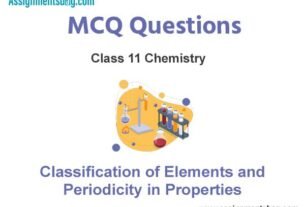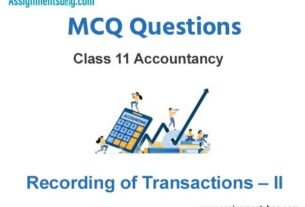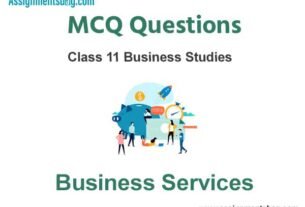Please refer to MCQ Questions Chapter 21 Neural Control and Coordination Class 11 Biology with answers provided below. These multiple-choice questions have been developed based on the latest NCERT book for class 11 Biology issued for the current academic year. We have provided MCQ Questions for Class 11 Biology for all chapters on our website. Students should learn the objective based questions for Chapter 21 Neural Control and Coordination in Class 11 Biology provided below to get more marks in exams.
Chapter 21 Neural Control and Coordination MCQ Questions
Please refer to the following Chapter 21 Neural Control and Coordination MCQ Questions Class 11 Biology with solutions for all important topics in the chapter.
MCQ Questions Answers for Chapter 21 Neural Control and Coordination Class 11 Biology
Question- Which of the following statement is correct?
(a) Electrical synapses are more common in our neural system than chemical synapses.
(b) The new potential in post-synaptic neuron may be either excitatory or inhibitory.
(c) Hypothalamus is the major coordination centre for sensory and motor signaling.
(d) The tracts of nerve fibres that connect two cerebral hemispheres are called corpora bigemina.
Answer
B
Question- Which of the following statements is correct?
(a) The internal ear receives sound waves and directs them to the ear drum.
(b) The membranous canals are suspended in the endolymph of the bony canals.
(c) The ear ossicles increase the efficiency of transmission of sound waves to the inner ear.
(d) The malleus is attached to the oval window and the stapes is attached to the temporal membrane of the cochlea.
Answer
C
Question- Fenestra ovalis is the opening of
(a) Cranium
(b) Tympanum
(c) Tympanic cavity
(d) Brain
Answer
C
Question- Which of the following statement is incorrect?
(a) The ear ossicle attached to tympanic membrane is malleus.
(b) Opsin (of rhodopsin) develops from vitamin A.
(c) The pressure on ear drum is equalized by Eustachian tube.
(d) Otolith organ consists of saccule and utricle.
Answer
B
Question- Identify the main functions of the cerebrum of human brain from the given statement.
(i) Control the contraction of voluntary muscles through the frontal lobe.
(ii) Control the sensitivity, movement, memory, vocabulary etc. through the frontal lobe.
(iii) Control the temperature, taste, touch, pain etc. through the parietal lobe.
(iv) Control the hearing and sense of smell through the occipital and frontal lobes.
(a) (i), (ii), (iv)
(b) (i) (iii), (iv)
(c) (i), (ii), (iii)
(d) (ii), (iii), (iv)
Answer
C
Question- Which of the following ions are required for nerve conduction ?
(a) Ca++, Na+ and K+
(b) Ca++ and Mg++
(c) Mg++ and K+
(d) Na+ and K
Answer
A
Question- All are None law (principle) states that
(a) all stimuli produce action potentials.
(b) any cell membrane can generate and propagate an action potential if stimulated to threshold value.
(c) potential difference can either be 0 or 100.
(d) the property of action potential is independent of the strength of depolarizing stimulus.
Answer
D
Question- Which statement regarding ‘stapes’ is correct?
(a) It lies in the auditory meatus.
(b) It fits onto the oval window.
(c) It conducts sound vibrations to fenestra rotundus.
(d) It is analogus to columella auris.
Answer
B
Question- Which of the following statements is correct regarding a myelinated nerve fibre?
(i) It is always associated with an axon.
(ii) It allows rapid conduction of nerve impulses.
(iii) It allows slow conduction of nerve impulses.
(iv) It has nodes of Ranvier.
(a) Only (i) and (ii)
(b) Only (i), (ii), and (iii)
(c) Only (i), (ii), and (iv)
(d) Only (i), (iii), and (iv)
Answer
C
Question- The black pigment in the eye which reduces the internal reflection is located in
(a) retina
(b) iris
(c) cornea
(d) sclerotic
Answer
A
Question- Which of the following statements is correct about rods compared to cones?
(i) Rods are most numerous in the fovea.
(ii) Rods contain rhodopsin.
(iii) Rods produce general outlines of objects rather than sharp images.
(iv) Rods produce black and white but not colour images.
(a) (i), and (ii) only
(b) (ii), and (iiii) only
(c) (i), (ii) and (iii) only
(d) (ii), (iii) and (iv) only
Answer
D
Question- The vagus nerve is the cranial nerve numbering
(a) 10th
(b) 9th
(c) 5th
(d) 8th
Answer
A
Question- Which of the following statement is correct?
(a) The space within cochlea called scala media is filled with endolymph.
(b) The vestibular apparatus is composed of two semicircular canals and the otolith organ consisting of the saccule and utricle.
(c) The external auditory meatus helps in equalizing the pressures on either sides of the ear drum.
(d) The membranes constituting cochlea, the reissner’s and basilar, divide the surrounding perilymph filled bony labyrinth into an upper scala tympani and a lower scala vestibuli.
Answer
A
Question- A person, who shows unpredictable moods, outbursts of emotion, quarrelsome behaviour and conflicts with others, is suffering from
(a) borderline personality disorder (BPD)
(b) mood disorder
(c) addictive disorder
(d) schizophrenia
Answer
A
Question- Which one of the following is mismatched ?
(a) Cerebrum – Memory
(b) Medulla oblongata – Temperature regulation
(c) Cerebellum – Equilibrium
(d) Olfactory lobes – Smell
Answer
B
Question-Excessive stimulation of vagus nerve in humans may lead to
(a) hoarse voice
(b) peptic ulcers
(c) efficient digestion of proteins
(d) irregular contraction of diaphragm
Answer
D
Question- Column I lists the parts of the human brain and column II lists the functions. Match the two columns and identify the correct option.
Column-I Column-II
A. Cerebrum I. Controls the pituitary
B. Cerebellum II. Controls vision and hearing
C. Hypothalamus III. Controls the rate of heart beat
D. Medulla oblongata IV. Maintains body posture
(a) A – II, B – IV, C – I, D – III
(b) A – IV, B – V, C – III, D – I
(c) A – V, B – IV, C – III, D – II
(d) A – V, B – V, C – I, D – II
Answer
A
Question- Hearing impairment affects which part of brain?
(a) Frontal lobe
(b) Parietal lobe
(c) Temporal lobe
(d) Cerebellum
Answer
C
Question- Which of the following statement is correct regarding cerebellum of brain?
(a) It is concerned with the maintenance of posture/ equilibrium.
(b) It is responsible for olfactory functions.
(c) It controls optic functions.
(d) both (a) and (c)
Answer
A
Question- . Which of the following statement is an example of conditioned reflex?
(a) Hand took up when piercing with a needle.
(b) Driving a vehicle.
(c) Eyes closed when any thing enter into it.
(d) In digestion food goes forward in alimentary canal.
Answer
B
Question- Bipolar nerve cells are present in
(a) Skin tactile corpuscles
(b) Spinal cord
(c) Retina of eye
(d) All the above
Answer
C
Question- Find out the right matching from the following pairs.
(a) Accommodation ……………… Pupil
(b) Colour perception ……………… Cones
(c) Night blindness ……………… Rods
(d) Binocular vision ……………… Iris
Answer
B
Question- Multipolar nerve cells are present in
(a) Cochlea
(b) Dorsal root ganglia of spinal cord
(c) Retina of eye
(d) Brain
Answer
B
Question- Match the column I (various phase of an action potential) with column II (ionic activity associated) and choose the correct option.
Column I Column II
A. Resting stage of a neuron I. Opening and then closing of the sodium channels
B. Depolarization phase II. All voltage gated sodium
in the generation of and potassium channels are closed.
an action potential.
C. Repolarization phase III. The sodium channels remain opened.
in the generation of
action potential
D. Absolute refractory IV. Opening of potassium gates and the rushing of potassium
phase.
(a) A – II, B – I, C – IV, D – III
(b) A – I, B – II, C – III, D – IV
(c) A – III, B – IV, C – I, D – II
(d) A – IV, B – II, C – III, D – I
Answer
A
Question- Select the answer with correct matching of the structure,its location and function. Structure Location Function
(a) Eustachian Anterior Equalizes air pressure tube part of on either sides of internal ear tympanic membrane
(b) Cerebellum Mid brain Controls respiration and gastric secretions
(c) Hypothalamus Fore brain Controls body temperature, urge for eating and drinking
(d) Blind spot Near the Rods and cones are place where present but inactive optic nerve here leaves the eye
Answer
C
Question- Select the correct match of the types of neuron present in column I with its location given in column II.
Column I Column II
A. Sclera I. The visible coloured portion of the eye.
B. Choroid II. Its diameter is regulated by the muscle fibres of iris.
C. Pupil III. Composed of a dense connective tissue
D. Fovea IV. Portion of the retina where only the cones are densely packed
E. Iris V. Contains many blood vessels and looks bluish in colour
(a) A – I; B – II; C – III; D – IV; E – V
(b) A – III; B – V; C – II; D – IV; E – I
(c) A – IV; B – I; C – V; D – II; E – IV
(d) A – V; B – IV; C – III; D – I; E – II
Answer
B
Question- Which of the following terms is not correctly matched with its feature?
(a) Efferent neurons – Carries signals from CNS to the effector.
(b) Axon terminal – Possess neurotransmitter containing vesicle.
(c) Limbic system – Along with the hypothalamus, it is involved in the regulation of sexual behaviour,expression of emotional reactions and motivation.
(d) Association areas – Present in cerebellum and responsible for functions like intersensory associations, memory and communication.
Answer
D
Question- Which of the following statements are correct?
(i) Somatic nervous system- Conducts impulses from CNS to skeletal muscles.
(ii) Autonomic nervous system- Conduct impulses from CNS to internal organ muscles.
(iii) Central nervous system- Consists of brain and spinal cord
(iv) Peripheral nervous system- Consists of nerves carrying impulses to brain and spinal cord only
(a) Only (ii) and (iii)
(b) Only (iii) and (iv)
(c) Only (i), (ii) and (iii)
(d) All of these
Answer
C
Question- Identify the correct match of types of neurons with its location.
(i) Unipolar neuron – Embryonic stage
(ii) Bipolar neuron – Cornea of eyes
(iii) Multipolar neuron – Cerebral cortex
(a) (i) & (ii) only
(b) (ii) & (iii) only
(c) (i) & (iii) only
(d) All the three
Answer
C
Question- For sound (good) reflex actions we require intact
(a) spinal cord
(b) cerebellum
(c) hypothalamus
(d) medulla oblongata
Answer
A
Question- Which of the following statement is correct regarding the organ of sight-eye?
(a) The space between cornea and lens is filled with transparent gel.
(b) When all cones are stimulated equally, a sensation of no light (dark) is produced.
(c) Rhodopsin is purplish red protein, hence called visual purple.
(d) The anterior transparent portion of choroid is called cornea.
Answer
C
Question- Which of the following events is involved in the transfer of information across a chemical synapse?
(i) Neurotransmitters bind to the postsynaptic receptors.
(ii) Calcium channels open in the presynaptic region.
(iii) Ion channels open in the postsynaptic membrane.
(iv) Direct flow of ions from one neuron to the next.
(a) (i) and (ii) only
(b) (i), (ii) and (iii) only
(c) (ii), (iii) and (iv) only
(d) All of the above
Answer
C
Question- Match the given terms in column I with its definition given in column II and choose the correct options.
Column I Column II
(Terms) (Definition)
A. Semi-circular canal I. Spiral organ of Corti
B. Vestibule II. Fluid found in the scala vestibule and scala tympani
C. Cochlea III. Evaluates rotational motion
D. Perilymph IV. Fluid found within the organ of Corti
E. Endolymph V. Responds to gravity and movements of the head
(a) A – III, B – V, C – I, D – II, E – IV
(b) A – I, B – II, C – III, D – IV, E – V
(c) A – II, B – III, C – IV, D – V, E – I
(d) A – IV, B – I, C – V, D – II, E – III
Answer
A
Question- The main cause of paralysis is
(a) some defect in muscles
(b) complete destruction of motor nerves
(c) complete destruction of sensory nerves
(d) none of the above
Answer
B
Question- An example of autonomous nervous system is
(a) swallowing food
(b) pupillary reflex
(c) peristalsis of intestine
(d) knee-jerk response
Answer
C
Question- During the propagation of a nerve impulse, the action potential results from the movement of
(a) Na+ ions from extracellular fluid to intracellular fluid.
(b) K+ ions from extracellular fluid to intracellular fluid.
(c) Na+ ions from intracellular fluid to extracellular fluid.
(d) K+ ions from intracellular fluid to extracellular fluid.
Answer
A
Question- Sensation of stomach pain is due to
(a) interoceptors
(b) exteroceptors
(c) teloreceptors
(d) all of these
Answer
A
Question- Which is the example of conditioned reflex ?
(a) Eyes closed when anything enter into it.
(b) Hand took up when piercing with needle.
(c) Salivation in a hungry dog in response to ringing of a bell.
(d) Digestion food goes forward in alimentary canal.
Answer
C
Question-Otorhinolaryngology is the study of
(a) brain cells
(b) bird anatomy
(c) locomotary organs
(d) ENT
Answer
D
Question- Which of the following pair is not correctly matched?
(a) Rods – Twilight vision
(b) Ciliary body – Iris
(c) Retina – Optic chiasma
(d) Vitreous humour – Posterior compartment
Answer
C
Question- Which of the following is not a mental disorder?
(a) Epilepsy
(b) Neurosis
(c) Psychosis
(d) Plague
Answer
D
Question- The 5th cranial nerve of frog is called
(a) optic nerve
(b) vagus nerve
(c) trigeminal nerve
(d) olfactory nerve
Answer
C
Question- The crystal of lead zirconate is a key component of
(a) electroencephalography
(b) electrocardiography
(c) magnetoencephalography
(d) sonography
Answer
D
Question- A person is wearing spectacles with concave lenses for correcting vision. While not using the glasses, the image of a distant object in his case will be formed
(a) on the blind spot
(b) behind the retina
(c) in front of the retina
(d) on the yellow spot
Answer
C
Question- Unidirectional transmission of a nerve impulse through nerve fibre is due to the fact that
(a) nerve fibre is insulated by a medullary sheath.
(b) sodium pump starts operating only at the cyton and then continues into the nerve fibre.
(c) neurotransmitters are released by dendrites and not by axon endings.
(d) neurotransmitters are released by the axon endings and not by dendrites
Answer
D
Question- Which one of the following is an example of a simple reflex ?
(a) Closing of eyes if an object suddenly approaches them.
(b) Climbing stairs in dark.
(c) Watering of mouth at the sight of delicious food.
(d) Tying laces while talking to and looking at another person.
Answer
A
Question- Which of the following is an eye disease?
(a) hepatitis
(b) measles
(c) glaucoma
(d) bronchitis
Answer
C
Question- In which animal nerve cell is present but brain is absent?
(a) Sponge
(b) Earthworm
(c) Cockroach
(d) Hydra
Answer
D
Question- Which one of the following is the correct difference between rod cells and cone cells of retina. Rod Cells Cone Cells
(a) Distribution More Evenly distributed concentrated all over retina in centre of retina
(b) Visual acuity High Low
(c) Visual pigment Iodopsin Rhodopsin contained
(d) Over all Vision in Colour vision and function poor light detailed vision in bright light
Answer
D
Question- Neurons receive signals through their __________ and send signals to other neurons through their __________.
(a) dendrites … receptors
(b) end feet … cell bodies and dendrites
(c) cell bodies and dendrites … axons
(d) transmitter vesicles … axons
Answer
C
Question- If frog’s brain is crushed, even then its leg moves on pinpointing . It is called
(a) simple reflex
(b) conditional reflex
(c) neurotransmitter function
(d) autonomic nerve conditions
Answer
A

We hope you liked the above provided MCQ Questions Chapter 21 Neural Control and Coordination Class 11 Biology with solutions. If you have any questions please ask us in the comments box below.


